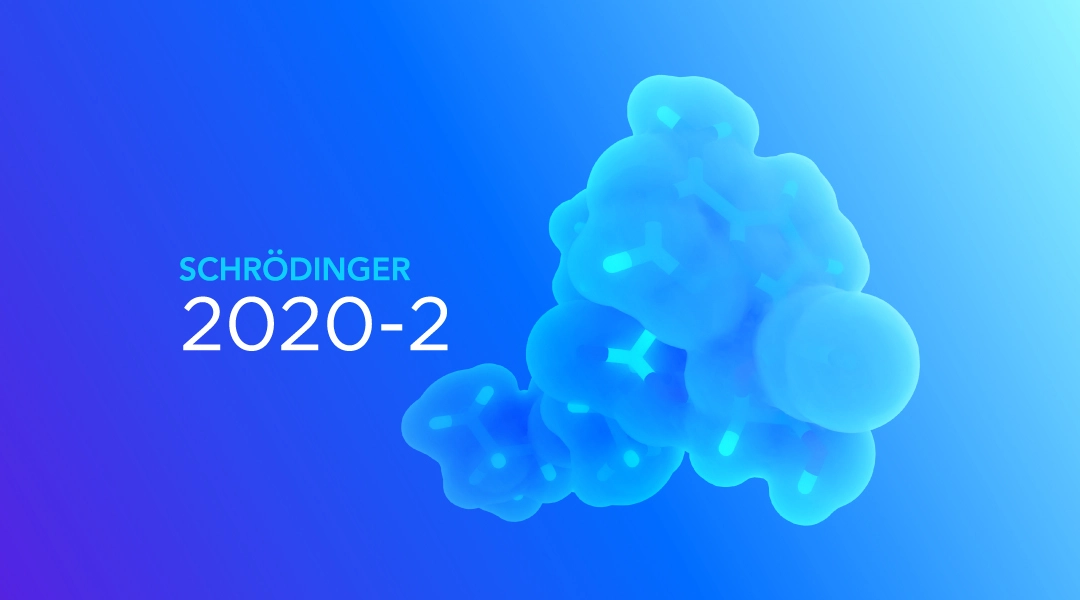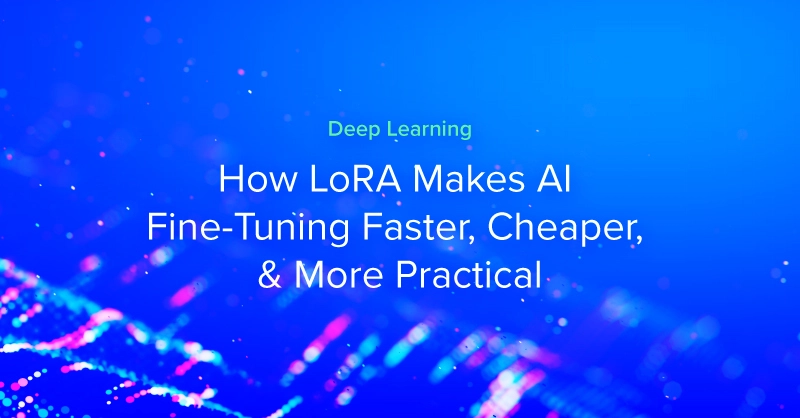
Schrödinger Software Release Overview
Schrödinger announced their software release 2020-2, which is available for download now. This quarterly release includes usability improvements and performance enhancements across all of their software offerings.
What is Schrödinger used for?
Schrödinger develops state-of-the-art chemical simulation software for use in pharmaceutical, biotechnology, and materials research. Their physics based computational platform leverages a deep understanding of physics, chemistry, and predictive modeling to accelerate innovation in drug discovery. This allows collaborators to discover high-quality, novel molecules more rapidly, at lower cost, and most likely with a higher likelihood of success compared to traditional methods.
Changes since Release 2020-1
SMALL-MOLECULE DRUG DISCOVERY
Maestro Graphical Interface
- Rapidly and easily perform manual or guided lead optimization with the Ligand Designer now in open beta [2020-2]
- “Design your way” with automatic prediction of protein-ligand complex geometry
- Whiteboard-like design in 2D
- Design ligands in 3D without protein
- Design ligands in 3D with simple view of protein interactions
- Design in full 3D with protein
- Overlay information critical to design
- See regions of the binding pocket available for ligand growth
- View protein-ligand interactions including clashes
- View protein and ligand surfaces
- View replaceable and displaceable water sites identified by WaterMap
- Recognize ligand bonds amenable to common medicinal chemistry reactions
- Guided workflows speed design
- Bioisostere replacement
- Isostere scanning
- Replace or displace water sites
- Form additional protein-ligand interactions
- Cyclize ligands
- Hybridize ligands (merge R-groups)
- Tailor chemistry to your project with custom R-group libraries and property filters
- Quickly assess molecular suitability with property-based radar plot (MW, logP, HBA, HBD, PSA)
- Send favorite designs for rank-ordering by affinity with FEP+, for post-processing and dissemination in LiveDesign, or to Excel
- “Design your way” with automatic prediction of protein-ligand complex geometry
- Support for Looking Glass Holographic Display [2020-2]
- Allow selection of residues involved in interactions [2020-2]
- Easily set measurements via the right-click context menu. [2020-2]
Multiple Sequence Viewer
- New heteromultimer homology modeling workflow [2020-2]
- Associating data with sequences: Import per-residue data from experiment or predictions and visualize it mapped onto amino acid sequences [2020-2]
OPLS3e Force Field
- FFBuilder integration of the Schrodinger-ANI neural network for 2X faster fitting (command line only) [2020-2]
FPsim-GPU
- Easily select or deselect all databases [2020-2]
Ligand Docking
- In MCS docking interface select to use flexible ligand alignment or produce docking-only alignments [2020-2]
- Dock from SMILES formats directly (*.smi or *.csv) with Glide to streamline virtual screening and facilitate large library screening [2020-2]
Macrocycles
- Optionally provide inputs to macrocyclization script by input file [2020-2]
- Generate fusion protein peptide-linkers designs, ADC linkers, and fuse dimeric ligands with ability link disconnected molecules (command line only) [2020-2]
Ligand Alignment
- Improved alignments for congeneric series with common scaffolds defined by Bemis-Murcko scaffold or SMARTS [2020-2]
- Improve reference ligand specification [2020-2]
- Update or create new entries for aligned ligands [2020-2]
Shape Screening
- Split a GPU Shape bin file into multiple files for processing in parallel across multiple GPUs [2020-2]
QM/MM (QSite)
- Dispersion-corrected functionals are now supported in the hydrogen-cap model [2020-2]
- The setting qsite_ff = opls3e in QSite input file activates OPLS3e [2020-2]
Quantum Mechanics
- Easily search, filter, and select from a large number of functionals and basis sets [2020-2]
- New functionals TPSS, SCAN, PKZB, SOGGA, SOGGA11, BOP [2020-2]
- Becke-Johnson’s and Sherrill’s dispersion corrections D3(BJ), D3M, and D3M(BJ) are available for a number of functionals [2020-2]
- Spectrum Plot panel can now visualize Jaguar-computed Raman spectra [2020-2]
- Script qm_descriptors.py which outputs QM descriptors now also outputs relative/absolute NMR shifts, Stockholder charges, and NBO charges [2020-2]
- Analytic NLO-V basis set optimized for polarizability calculations is available [2020-2]
- Maximum number of iterations in PBF implicit solvent calculations can be controlled by the keyword maxpbfit [2020-2]
- 1D/2D distributed_scan.py jobs output a .grd file even if some subjobs fail [2020-2]
- NMR chemical shifts are available for a number of dispersion-corrected functionals [2020-2]
Workflows & Pipelining
- The 3D structure type (hence the rendering) and execution mode (automatic/run for each cell) can be controlled in the Upload model to LiveDesign node [2020-2]
- Surfaces and images can be added to the LiveReport [2020-2]
- New Prime Macrocycle Conformation sampling node [2020-2]
- The Molecule reader node takes in cif format [2020-2]
- The Export image to LiveDesign node supports SVG images [2020-2]
BIOLOGICS
General
- Added 2-aminobutryic acid (2AB) and 2-aminoisobutryic acid (Aib) to default non-native amino acid library [2020-2]
- In peptide docking select from recently used grids [2020-2]
MATERIALS SCIENCE
General
- GUI for Quantum ESPRESSO [2020-2]
- Raman spectrum from periodic DFT (command-line)
- Option to choose grid plane distance for convergence test
- Support for use periodic DFT data in Elastic Constants Results
- Access to D3 Grimme dispersion correction from GUI
- DOS, PDOS, and charge density computed with hybrid functionals
- Transport Calculations via MD simulations [2020-2]
- Driver for Diffusion Coefficient (CPU) to run separately from GPU MD
- Morphology Tools [2020-2]
- Powder indexing removed from feature flag
- External DICVOL installation as option (not requirement)
- Prediction of Bravais lattice type
- Support for exporting results
- Powder indexing removed from feature flag
Builders and Tools
- Curve/Plot digitization tool [2020-2]
- Counterions with charged surfactants in Structured Liquid Builder [2020-2]
- Support for _atom_site_disorder_group in Crystal Builder [2020-2]
- Atom site labels in Crystal Builder [2020-2]
- Speed-up for building > 1M-atom system in Disordered System Builder [2020-2]
- Support for varying surface termination depth from Slabs and Interfaces [2020-2]
Classical Mechanics
- Averaging results from multiple sets of data for Stress Strain [2020-2]
- Yield strain prediction in Stress-Strain Analysis [2020-2]
- Uncertainty for yield strain marked in Stress-Strain Analysis [2020-2]
- Support for yield strain predictions in Uncertainty Quantification [2020-2]
- Improved error messages for failed residual strain calculations [2020-2]
- Support of stress-based prediction for Elastic Constants [2020-2]
- Option to selectively skip data in Uncertainty pooling analysis [2020-2]
- Tensors tab added in Elastic Constants Results [2020-2]
- All elastic/stress tensor components written to a log for Elastic Constants [2020-2]
- Option to generate PDF report from Thermophysical Properties Viewer [2020-2]
- MD Multistage relaxation protocols for semi-crystalline polymers [2020-2]
- Reduced use of disk space for H-bond autocorrelation calculation [2020-2]
- Option to run Polymer Chain Analysis on CPU for existing trajectories [2020-2]
Quantum Mechanics
- Reaction Workflow: Control of tolerance towards negative frequencies [2020-2]
- Reaction Workflow: Anharmonic corrections [2020-2]
- Improved rotation of η-ligands in Auto Reaction Workflow [2020-2]
- Restart option for Auto Reaction Workflow [2020-2]
- Support for substrate enumeration in Auto Reaction Workflow [2020-2]
- Improved Band Shape GUI logic with restart option [2020-2]
- Peak info written to *_bandshape_simplified.out for Band Shape [2020-2]
- Weakest bond energy reported for Bond and Ligand Dissociation Energy [2020-2]
- Computing energy gradient for double hybrid DFT functionals [2020-2]
- Option to create entries for all iterations from QM Convergence [2020-2]
Click here to view the new features video.
To view a list of known issues in Release 2020-2 please click here.

Schrödinger Software Release 2020-2
Schrödinger Software Release Overview
Schrödinger announced their software release 2020-2, which is available for download now. This quarterly release includes usability improvements and performance enhancements across all of their software offerings.
What is Schrödinger used for?
Schrödinger develops state-of-the-art chemical simulation software for use in pharmaceutical, biotechnology, and materials research. Their physics based computational platform leverages a deep understanding of physics, chemistry, and predictive modeling to accelerate innovation in drug discovery. This allows collaborators to discover high-quality, novel molecules more rapidly, at lower cost, and most likely with a higher likelihood of success compared to traditional methods.
Changes since Release 2020-1
SMALL-MOLECULE DRUG DISCOVERY
Maestro Graphical Interface
- Rapidly and easily perform manual or guided lead optimization with the Ligand Designer now in open beta [2020-2]
- “Design your way” with automatic prediction of protein-ligand complex geometry
- Whiteboard-like design in 2D
- Design ligands in 3D without protein
- Design ligands in 3D with simple view of protein interactions
- Design in full 3D with protein
- Overlay information critical to design
- See regions of the binding pocket available for ligand growth
- View protein-ligand interactions including clashes
- View protein and ligand surfaces
- View replaceable and displaceable water sites identified by WaterMap
- Recognize ligand bonds amenable to common medicinal chemistry reactions
- Guided workflows speed design
- Bioisostere replacement
- Isostere scanning
- Replace or displace water sites
- Form additional protein-ligand interactions
- Cyclize ligands
- Hybridize ligands (merge R-groups)
- Tailor chemistry to your project with custom R-group libraries and property filters
- Quickly assess molecular suitability with property-based radar plot (MW, logP, HBA, HBD, PSA)
- Send favorite designs for rank-ordering by affinity with FEP+, for post-processing and dissemination in LiveDesign, or to Excel
- “Design your way” with automatic prediction of protein-ligand complex geometry
- Support for Looking Glass Holographic Display [2020-2]
- Allow selection of residues involved in interactions [2020-2]
- Easily set measurements via the right-click context menu. [2020-2]
Multiple Sequence Viewer
- New heteromultimer homology modeling workflow [2020-2]
- Associating data with sequences: Import per-residue data from experiment or predictions and visualize it mapped onto amino acid sequences [2020-2]
OPLS3e Force Field
- FFBuilder integration of the Schrodinger-ANI neural network for 2X faster fitting (command line only) [2020-2]
FPsim-GPU
- Easily select or deselect all databases [2020-2]
Ligand Docking
- In MCS docking interface select to use flexible ligand alignment or produce docking-only alignments [2020-2]
- Dock from SMILES formats directly (*.smi or *.csv) with Glide to streamline virtual screening and facilitate large library screening [2020-2]
Macrocycles
- Optionally provide inputs to macrocyclization script by input file [2020-2]
- Generate fusion protein peptide-linkers designs, ADC linkers, and fuse dimeric ligands with ability link disconnected molecules (command line only) [2020-2]
Ligand Alignment
- Improved alignments for congeneric series with common scaffolds defined by Bemis-Murcko scaffold or SMARTS [2020-2]
- Improve reference ligand specification [2020-2]
- Update or create new entries for aligned ligands [2020-2]
Shape Screening
- Split a GPU Shape bin file into multiple files for processing in parallel across multiple GPUs [2020-2]
QM/MM (QSite)
- Dispersion-corrected functionals are now supported in the hydrogen-cap model [2020-2]
- The setting qsite_ff = opls3e in QSite input file activates OPLS3e [2020-2]
Quantum Mechanics
- Easily search, filter, and select from a large number of functionals and basis sets [2020-2]
- New functionals TPSS, SCAN, PKZB, SOGGA, SOGGA11, BOP [2020-2]
- Becke-Johnson’s and Sherrill’s dispersion corrections D3(BJ), D3M, and D3M(BJ) are available for a number of functionals [2020-2]
- Spectrum Plot panel can now visualize Jaguar-computed Raman spectra [2020-2]
- Script qm_descriptors.py which outputs QM descriptors now also outputs relative/absolute NMR shifts, Stockholder charges, and NBO charges [2020-2]
- Analytic NLO-V basis set optimized for polarizability calculations is available [2020-2]
- Maximum number of iterations in PBF implicit solvent calculations can be controlled by the keyword maxpbfit [2020-2]
- 1D/2D distributed_scan.py jobs output a .grd file even if some subjobs fail [2020-2]
- NMR chemical shifts are available for a number of dispersion-corrected functionals [2020-2]
Workflows & Pipelining
- The 3D structure type (hence the rendering) and execution mode (automatic/run for each cell) can be controlled in the Upload model to LiveDesign node [2020-2]
- Surfaces and images can be added to the LiveReport [2020-2]
- New Prime Macrocycle Conformation sampling node [2020-2]
- The Molecule reader node takes in cif format [2020-2]
- The Export image to LiveDesign node supports SVG images [2020-2]
BIOLOGICS
General
- Added 2-aminobutryic acid (2AB) and 2-aminoisobutryic acid (Aib) to default non-native amino acid library [2020-2]
- In peptide docking select from recently used grids [2020-2]
MATERIALS SCIENCE
General
- GUI for Quantum ESPRESSO [2020-2]
- Raman spectrum from periodic DFT (command-line)
- Option to choose grid plane distance for convergence test
- Support for use periodic DFT data in Elastic Constants Results
- Access to D3 Grimme dispersion correction from GUI
- DOS, PDOS, and charge density computed with hybrid functionals
- Transport Calculations via MD simulations [2020-2]
- Driver for Diffusion Coefficient (CPU) to run separately from GPU MD
- Morphology Tools [2020-2]
- Powder indexing removed from feature flag
- External DICVOL installation as option (not requirement)
- Prediction of Bravais lattice type
- Support for exporting results
- Powder indexing removed from feature flag
Builders and Tools
- Curve/Plot digitization tool [2020-2]
- Counterions with charged surfactants in Structured Liquid Builder [2020-2]
- Support for _atom_site_disorder_group in Crystal Builder [2020-2]
- Atom site labels in Crystal Builder [2020-2]
- Speed-up for building > 1M-atom system in Disordered System Builder [2020-2]
- Support for varying surface termination depth from Slabs and Interfaces [2020-2]
Classical Mechanics
- Averaging results from multiple sets of data for Stress Strain [2020-2]
- Yield strain prediction in Stress-Strain Analysis [2020-2]
- Uncertainty for yield strain marked in Stress-Strain Analysis [2020-2]
- Support for yield strain predictions in Uncertainty Quantification [2020-2]
- Improved error messages for failed residual strain calculations [2020-2]
- Support of stress-based prediction for Elastic Constants [2020-2]
- Option to selectively skip data in Uncertainty pooling analysis [2020-2]
- Tensors tab added in Elastic Constants Results [2020-2]
- All elastic/stress tensor components written to a log for Elastic Constants [2020-2]
- Option to generate PDF report from Thermophysical Properties Viewer [2020-2]
- MD Multistage relaxation protocols for semi-crystalline polymers [2020-2]
- Reduced use of disk space for H-bond autocorrelation calculation [2020-2]
- Option to run Polymer Chain Analysis on CPU for existing trajectories [2020-2]
Quantum Mechanics
- Reaction Workflow: Control of tolerance towards negative frequencies [2020-2]
- Reaction Workflow: Anharmonic corrections [2020-2]
- Improved rotation of η-ligands in Auto Reaction Workflow [2020-2]
- Restart option for Auto Reaction Workflow [2020-2]
- Support for substrate enumeration in Auto Reaction Workflow [2020-2]
- Improved Band Shape GUI logic with restart option [2020-2]
- Peak info written to *_bandshape_simplified.out for Band Shape [2020-2]
- Weakest bond energy reported for Bond and Ligand Dissociation Energy [2020-2]
- Computing energy gradient for double hybrid DFT functionals [2020-2]
- Option to create entries for all iterations from QM Convergence [2020-2]
Click here to view the new features video.
To view a list of known issues in Release 2020-2 please click here.






.jpg?format=webp)